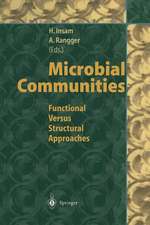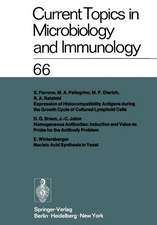Rhizobiont in Bioremediation of Hazardous Waste
Editat de Vivek Kumar, Ram Prasad, Manoj Kumaren Limba Engleză Paperback – 23 mai 2022
| Toate formatele și edițiile | Preț | Express |
|---|---|---|
| Paperback (1) | 1122.42 lei 6-8 săpt. | |
| Springer Nature Singapore – 23 mai 2022 | 1122.42 lei 6-8 săpt. | |
| Hardback (1) | 1128.89 lei 6-8 săpt. | |
| Springer Nature Singapore – 22 mai 2021 | 1128.89 lei 6-8 săpt. |
Preț: 1122.42 lei
Preț vechi: 1368.80 lei
-18% Nou
Puncte Express: 1684
Preț estimativ în valută:
214.79€ • 225.85$ • 177.47£
214.79€ • 225.85$ • 177.47£
Carte tipărită la comandă
Livrare economică 17 aprilie-01 mai
Preluare comenzi: 021 569.72.76
Specificații
ISBN-13: 9789811606045
ISBN-10: 9811606048
Ilustrații: XII, 592 p. 90 illus., 63 illus. in color.
Dimensiuni: 155 x 235 mm
Greutate: 0.84 kg
Ediția:1st ed. 2021
Editura: Springer Nature Singapore
Colecția Springer
Locul publicării:Singapore, Singapore
ISBN-10: 9811606048
Ilustrații: XII, 592 p. 90 illus., 63 illus. in color.
Dimensiuni: 155 x 235 mm
Greutate: 0.84 kg
Ediția:1st ed. 2021
Editura: Springer Nature Singapore
Colecția Springer
Locul publicării:Singapore, Singapore
Cuprins
1 Plant-Microbe Interactions for Bioremediation of Pesticides.- 2 Combined and Sustainable Techniques in Remediation of POPs- Contaminated Soil Sites.- 3 Biosurfactants: A Green and Sustainable Remediation Alternative.- 4 Biosurfactants Mediated Remediation of Heavy Metals- A Review.- 5 Surface-Active Agents from Pseudomonas Emulsify N-Hexadecane: Past, Present and Future Trends.- 6 Application of Bio-Nanoparticles in Biotechnological Process Focusing in Bioremediation.- 7 Plant-Microbe Interactions in Attenuation of Toxic Waste in Ecosystem.- 8 Biotransformation of Pollutants: A Microbiological Perspective.- 9 Plant-Microbe Interactions in Bioremedation of Toxic Wastes in Tropical Environment.- 10 Advance Bioremediation Strategies for Mitigation of Chromium and Organics Pollution in Tannery.- 11 Current Approaches in Bioremediation of Toxic Contaminants by Application of Microbial Cells; Biosurfactants and Bioemulsifiers of Microbial Origin.- 12 Microbial Scavenging of Heavy Metals using Bioremediation strategies.- 13 Plant-Microbe Interaction in Attenuation of Toxic Wastes in Ecosystem.- 14 PGPR in Management of Soil Toxicity.- 15 Earthworms, Plants and GMO’s Towards Natural Bioremediation.- 16 Mitigation of Hazardous Contaminants: A Phyto-Microbiome Approach.- 17 Microbes: A Potential Tool for Bioremediation.- 18 Physical, Chemical and Biological Remediation Techniques for Textile Effluents in context with Developed and Developing Countries.- 19 Remediation of Toxic Environmental Pollutants Using Nanoparticles and Integrated Nano-Bio Systems.- 20 Bioremediation of Wastewaters.- 21 Occurrence and Attenuation of Antibiotics in Water Using Biomass-Derived Materials.- 22 Mangrove Forest Pollution and Re mediation in the Rhizosphere.- 23 Biotherapeutic Approaches: Bioremediation of Industrial Heavy Metals from Ecosphere.
Notă biografică
Dr. Vivek Kumar is an Associate Professor at the Himalayan School of Biosciences, Swami Rama Himalayan University, Jolly Grant, Dehradun, India. He leads the plant-microbe-interaction and microbial ecology research group at his institute. He serves as an editor and reviewer of several reputed international journals and research projects. He has more than hundred publications to his credit including research papers, book chapters and review articles. He has also authored one practical manual book and edited several books with Springer Nature. Dr. Kumar also served as Microbiologist for eight years in Department of Soil and Water Research, Public Authority of Agricultural Affairs & Fish Resources, Kuwait, where he was involved in policy research, advisory services and projects formulation related to sustainable agriculture and environment in Kuwait. He has been credited with first time reporting and identification of Pink Rot inflorescence disease of Date palm in Kuwait caused by Serratia marcescens. He has also organized number of conferences/workshops as convener/ organizing secretary. He has been awarded ‘Young Scientist Award’ for the year 2002 in ‘Agricultural Microbiology’ by the Association of Microbiologists of India (AMI).
Dr. Ram Prasad is an Associate Professor at the Department of Botany, Mahatma Gandhi Central University, Motihari, Bihar, India. His research interest includes applied microbiology, plant-microbe interactions, sustainable agriculture, and nanobiotechnology. Dr. Prasad has more than 150 publications to his credit, including research papers, review articles & book chapters and five patents issued or pending. He has also edited and authored several books. Dr. Prasad has twelve years of teaching experience and has been awarded the Young Scientist Award & Prof. J.S. Datta Munshi Gold Medal by the International Society for Ecological Communications; FSAB fellowship by the Society for Applied Biotechnology; the American Cancer Society UICC International Fellowship for Beginning Investigators, USA; Outstanding Scientist Award in the field of Microbiology by Venus International Foundation; BRICPL Science Investigator Award and Research Excellence Award. He serves as an editorial board member in Frontiers in Microbiology, Frontiers in Nutrition, Academia Journal of Biotechnology, Phyton, International Journal of Experimental Botany including Series editor of Nanotechnology in the Life Sciences, Springer Nature, USA. Previously, Dr. Prasad served as Assistant Professor Amity University Uttar Pradesh, India; Visiting Assistant Professor, Whiting School of Engineering, Department of Mechanical Engineering at Johns Hopkins University, United States and Research Associate Professor at School of Environmental Science and Engineering, Sun Yat-sen University, Guangzhou, China.
Dr. Manoj Kumar is an Associate Professor and Head, Centre for Life Sciences, Central University of Jharkhand, Ranchi, Jharkhand. Dr. Kumar has 16 years of research and teaching experience in the field of plant developmental biology. He has been associated with Bhagalpur University, Jawaharlal Nehru University, University of Pretoria, University of Melbourne, University of Ton Duc Thang for doctoral, postdoctoral research as well as visiting scientist. He has published valuable research in reputed journals and edited books. He has guided several students at master, M. Phil., doctorate and post-doctorate levels. He has been principle investigator of several projects of national funding agencies – DBT, DRDO etc. He is associated as editor and reviewer with several research journals and offering consultancy to several biotechnology firms at international level.
Dr. Ram Prasad is an Associate Professor at the Department of Botany, Mahatma Gandhi Central University, Motihari, Bihar, India. His research interest includes applied microbiology, plant-microbe interactions, sustainable agriculture, and nanobiotechnology. Dr. Prasad has more than 150 publications to his credit, including research papers, review articles & book chapters and five patents issued or pending. He has also edited and authored several books. Dr. Prasad has twelve years of teaching experience and has been awarded the Young Scientist Award & Prof. J.S. Datta Munshi Gold Medal by the International Society for Ecological Communications; FSAB fellowship by the Society for Applied Biotechnology; the American Cancer Society UICC International Fellowship for Beginning Investigators, USA; Outstanding Scientist Award in the field of Microbiology by Venus International Foundation; BRICPL Science Investigator Award and Research Excellence Award. He serves as an editorial board member in Frontiers in Microbiology, Frontiers in Nutrition, Academia Journal of Biotechnology, Phyton, International Journal of Experimental Botany including Series editor of Nanotechnology in the Life Sciences, Springer Nature, USA. Previously, Dr. Prasad served as Assistant Professor Amity University Uttar Pradesh, India; Visiting Assistant Professor, Whiting School of Engineering, Department of Mechanical Engineering at Johns Hopkins University, United States and Research Associate Professor at School of Environmental Science and Engineering, Sun Yat-sen University, Guangzhou, China.
Dr. Manoj Kumar is an Associate Professor and Head, Centre for Life Sciences, Central University of Jharkhand, Ranchi, Jharkhand. Dr. Kumar has 16 years of research and teaching experience in the field of plant developmental biology. He has been associated with Bhagalpur University, Jawaharlal Nehru University, University of Pretoria, University of Melbourne, University of Ton Duc Thang for doctoral, postdoctoral research as well as visiting scientist. He has published valuable research in reputed journals and edited books. He has guided several students at master, M. Phil., doctorate and post-doctorate levels. He has been principle investigator of several projects of national funding agencies – DBT, DRDO etc. He is associated as editor and reviewer with several research journals and offering consultancy to several biotechnology firms at international level.
Textul de pe ultima copertă
This book describes many novel approaches of microbial bioremediation including conventional and modern approaches, metagenomics, biosurfactants and nano-based bioremediation. Also presents up-to-date knowledge about biodegradation of solid and liquid contaminants in the rhizospheric zone by plant (rhizo)-microbiome interface. It also illustrates communication pathways based on evolving methodologies, bioinformatic tools which provides insights into the functional dynamics of bioremediation process by the host-microbiome interface. The different chapters explain the mechanism and outcomes during the process of bioremediation. The book broadly depicts the following: Advances in bioremediation through nanoremediation, rhizo-remediation, bioremediation of different ecosystems like polluted waters, industrial effluents, bioremediation of metal and organic pollutants, toxic dyes etc. The book is very useful for researchers and students in the fields of applied and environmental microbiology. It is also meant for industry experts and professionals working in the field of bioremediation and waste management.
Caracteristici
Describes basic principles and novel approaches of microbial bioremediation including genetic engineering, metagenomics, in silico approach, biological surfactants, biosorption and biofilm based bioremediation Discusses bioremediation of precarious elements like oil spills, metal and dye waste water, polyethylene wastes, polluted agro-ecosystem and xenobiotics Delivers innovative practices of bioremediation including next-generation techniques, potential microbial community dynamics in biodegradation and bioremediation, phytoremediation, wetland phytorhizosphere and more

























